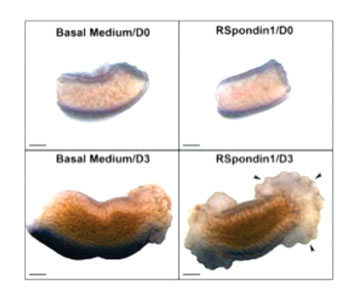Gut Segments Reunite in Model Culture System
By LabMedica International staff writers
Posted on 08 Sep 2015
An organ culture model system was created to evaluate physical manipulations aimed at enhancing the healing of gut segments in order to generate a single functional organ.Posted on 08 Sep 2015
Investigators at the University of Manchester (United Kingdom) worked with embryonic mouse jejunum, which was isolated and cut into tubes two to three millimeters in length. The paired segments separated by a small gap (about one millimeter) were placed in growth medium on semi-permeable supports. Each pair of segments was linked by a nylon suture threaded through their lumens.

Image: Embryonic bowel explants were cultured for three days in basal media alone or this media supplemented with R-Spondin 1. Note that, in the latter condition, there was exuberant growth of tissue from the ends of explants. Bars are 250 microns long (Photo courtesy of the University of Manchester).
Results published in the August 3, 2015, online edition of the Journal of Tissue Engineering and Regenerative Medicine revealed that after three days in organ culture fed by defined serum-free media, the rudiments differentiated to form tubes of smooth muscle surrounding a core of rudimentary villi. Of 34 such pairs, 74% had touching and well aligned proximate ends. Of these joined structures, 80% (59% of the total pairs) had a continuous lumen, as assessed by observing the trajectories of fluorescent dextrans injected into their distal ends. Fused organ pairs formed a single functional unit, as assessed by spontaneous contraction waves propagated along their lengths.
In some experiments the investigators added a growth factor called R-spondin 1 to the medium in an attempt to accelerate growth and make it more successful. Although this caused faster growth, it failed to establish the bridge in as uniform a way and fusion was less successful.
Senior author Dr. Adrian Woolf, professor of pediatric science at the University of Manchester, said, "The ability to study organs outside of the body is delivering new insights into how they work. In this case we have been able to study damaged intestines and instigate repairs which could lead to treatment in a number of conditions. In this study we managed to bridge a gap of less than one millimeter, but for this to be useful in conditions like short bowel syndrome we will need to promote growth across much larger distances. Having the ability to test different vitamins and hormones which promote growth opens up many new possibilities for future treatments."
Related Links:
University of Manchester




 assay.jpg)









